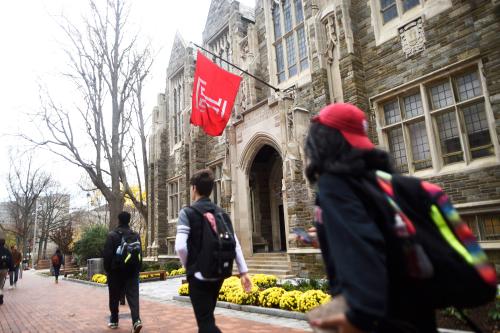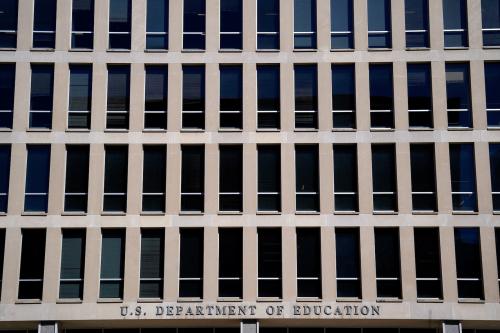Currently, more than half of students at public four-year institutions in the U.S. borrow to finance their education, and there has been troubling growth in student loan default rates and repayment burdens in recent years. A prominent risk is that students are borrowing without understanding how to determine a debt level appropriate to their objectives or without clear information about the implications of their choices.
In response to concerns that students are making mistakes that better information could mitigate, a handful of states have enacted laws requiring their universities to distribute debt letters to their students, and numerous universities have started to send debt letters as a central component of student loan information campaigns. Debt letters, akin to an annual financial account statement on student borrowing, are a low-touch approach to inform and remind students about the amount they borrowed and expected future payments.
Unfortunately, debt letters are unlikely to lead to the large-scale changes in student loan borrowing that many hope they will. To be clear, we believe that these notifications are sensible initiatives that can provide students with much-needed and timely information. Nonetheless, our research using different methodological approaches at two distinct four-year public university settings, suggests that we should have modest expectations about the efficacy of such letters, and that they are unlikely to lead to systematic changes in students’ borrowing behavior. And, a laser focus on these letters as a standalone intervention has the potential to preclude other needed solutions that can encourage students to make good decisions about if, when, and where to go to college, and how to pay for it.
The evidence
In the first study, Rajeev Darolia and Cassandra Harper implemented a field experiment in partnership with the financial aid office at the University of Missouri. They randomly assigned half of all undergraduate students who borrowed student loans to receive individually tailored letters with information about their borrowing. These authors compared the borrowing choices of the students who received the letter with students who were not given additional information. The letter did not affect students’ likelihood of borrowing or amount borrowed. The authors conducted in-depth semi-structured interviews to supplement findings from the experiment and found that students were purposefully deferring attention to the implications of their student loans, limiting the value of the letters. As a positive result, the letter induced students to interact more with financial aid professionals, which could have long-term benefits even if the letter did not affect current borrowing.
In a second study, the Office of Student Success at Montana State University sent debt letters to students with above average levels of borrowing warning them that they could be incurring debt that they might not be able to repay, and also encouraging students to complete credits in a timely manner. Christiana Stoddard, Carly Urban, and Max Schmeiser analyzed this intervention by examining the choices students made before and after receiving the letter, and also compared choices to those by similar students at the University of Montana, a sister institution that did not implement loan or information interventions at the same time. The letter did not change the incidence or amount that students borrowed after receiving the letter; however, the authors found positive effects of the letter on retention rates, grades and credit completion.
Explanations
There is evidence that many students do not understand how much they borrow, that the benefits of federally mandated entrance loan counseling are limited, and that changing loan choice architecture can affect student borrowing. So why do our findings suggest that student loan debt letters have limited effects on borrowing behavior? Both the University of Missouri and Montana State University are four-year state flagship universities, where average debt levels are relatively low. Results may differ at schools with dissimilar student bodies or higher sticker prices, where students rely more heavily on loans. Another reason for the absence of an effect could be that debt letters are passive and do not induce immediate action. Students may also be more responsive to information prior to initiating loans, rather than after they have already begun a pattern of borrowing as in these studies. Thus, improving the delivery, timing, manner, and modality of debt letters could improve their efficacy, though resource and legal constraints are likely to impede some of these efforts if debt letter policies are implemented at scale.
Perhaps the biggest reason debt letters do not reduce debt, however, is because they provide students needed information, but not the skills to evaluate available financing options. For many traditional-aged students, being confronted with a student loan offer will bring about the first complex financial decision they will make. As such, many students do not have the expertise or experience to weigh available data.
Conclusion
We need to have serious conversations about whether the current finance system is providing students an opportunity to attend and succeed in college. But, given the current limits of grant aid, borrowing is an appropriate and necessary choice for many students to achieve the economic returns that higher education generally confers.
Therefore, if we expect students to make good decisions about loans, we need to help students develop the skills to properly process available information. Programs that support students’ efforts to develop this capacity–such as counseling, mentoring, and financial literacy courses before, during, and after college–are more expensive than low-touch informational initiatives. However, they have the potential to equip students with the necessary tools to make important decisions during the college period and beyond, and thus represent investments worthy of further consideration.
The Brookings Institution is committed to quality, independence, and impact.
We are supported by a diverse array of funders. In line with our values and policies, each Brookings publication represents the sole views of its author(s).








